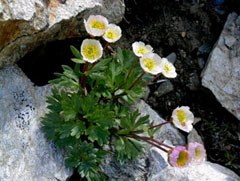News
Climate change impacts biodiversity
Jan 18, 2007
/
CIPRA Internationale Alpenschutzkommission
For a number of years now, biodiversity in Alpine ecosystems has been declining under the effect of climate change.

Image caption:
Der Gletscherhahnenfuss gehört zu den kälteliebenden Verlierern der derzeitigen Artenverschiebungen im Hochgebirge. © http://www.bruehlmeier.info
That is the conclusion reached by the mountain research network GLORIA by a current study. It shows that a decline in biodiversity and shifts in species can be observed near the vegetation's nival boundary. Over the period 1994 to 2004 scientists at the University of Vienna/A studied observation areas situated at altitudes ranging between 2,900 and 3,450 m above sea level in the Stubai Alps/A; they noted that more and more alpine pioneer species were spreading from lower to higher altitudes as a result of species migration. By contrast specialist high-alpine plants adapted to the cold are increasingly being displaced. Overall the number of species in high alpine regions is rapidly declining. These results are worrying not least in view of the fact that around one fifth of all European plant species occur only above the tree line in high mountain regions.
In other words climate change is not a future scenario; it is already a reality. That is why environmental associations are critical of the recently announced action plan by the EU which provides for a lower reduction in CO2 emissions than previously planned.
Sources: www.juraforum.de/jura/news/news/p/1/id (de), www.sueddeutsche.de/wissen/artikel/855/94761/ (de)
In other words climate change is not a future scenario; it is already a reality. That is why environmental associations are critical of the recently announced action plan by the EU which provides for a lower reduction in CO2 emissions than previously planned.
Sources: www.juraforum.de/jura/news/news/p/1/id (de), www.sueddeutsche.de/wissen/artikel/855/94761/ (de)



